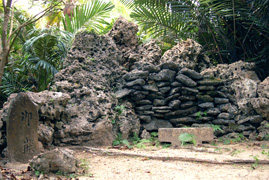Traditional Okinawa Village and Omoro Arboretum
- HOME
- Facilities
- Native Okinawan Village and Omoro Botanical Garden
- Learning from native village
- The origin of villages
The origin of villages
The mechanism of the formation of a traditional village, Come across people from long ago
The villages of Okinawa are more or less built on a hillside or on a slope at the foot of a hill with a small hill in the back on the northern side called the “Forest of Kusate”. On the uppermost part in the middle (or on the left or right side) of the hill is the residence of the community’s head family, and one step lower are the residences of the second ranked families in line to the left and right, and further below on the front side of the hill are the residences of the branch families spreading out wide toward the bottom.
Also, in the back of the residence of the head family is a “Utaki” where the guardian god is enshrined, and there is a path called “God’s path” that stretches from the residence of the head family to the Utaki.


The gods of Nirai-kanai who bring happiness to people from across the sea are invited to a spot located on top of a hill with a distant view of the ocean. This is how the people of Okinawa have built villages surrounded by the sea and forests.
- The use of the word “village” began around the time when the Shimazu clan came to the Ryukyus, and until then it was called “Makyo (Maki)” which stands for community.
- The small hill called the “Forest of Kusate” is the place where god is enshrined.
- The place where god is enshrined within the structure of the “Utaki” is called “Ibi”. The front of the “Ibi” is called “Ibinumeh” where an incense burner made of rock and a stone pedestal is placed.










